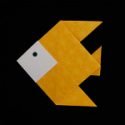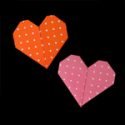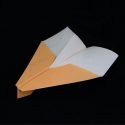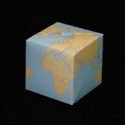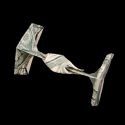Designing Origami
Before you Design…
 Before you launch your own origami studio, it might be prudent to practice folding the models created by others first. In addition to folding simple, intermediate, and complex models, you can also try the different styles of origami (Pureland origami, tessellations, wet folding,…).
Before you launch your own origami studio, it might be prudent to practice folding the models created by others first. In addition to folding simple, intermediate, and complex models, you can also try the different styles of origami (Pureland origami, tessellations, wet folding,…).
There is much to learn. With “simple” models, take the time to examine how the folds translate into the final model. With “complex” models, master the skills to execute those tricky paper manipulations. Different styles of origami will give you an opportunity to explore the world of origami other than the one you are familiar with. Give it a try, you’ll find methodologies to add to your origami tool box. [Photo: Design Studio from Amazon.com]
Moving forward…
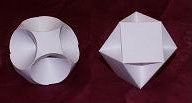 At some point in your origami journey, you will start modifying models created by other people. Folding the same model over and over again is good but what happens if you make a fold at a slightly different angle? What happens if you add an extra fold? [Photo: Mosely’s orb is converted to a cubahedron by changing the curves to straight creases.]
At some point in your origami journey, you will start modifying models created by other people. Folding the same model over and over again is good but what happens if you make a fold at a slightly different angle? What happens if you add an extra fold? [Photo: Mosely’s orb is converted to a cubahedron by changing the curves to straight creases.]
These diversons are certainly worthwhile and much can be learned from them. Sometimes the changes you incorporated do not give you the anticipated results. Sometimes, the modifications make the model look worst! These are important lessons and you need to experiment with other people’s models in order to understand why models are designed the way they are.
Creative Design…
 In the origami world, there is a process called “Doodling”. Doodling is an unconscience process where a piece of paper is folded with no particular result or target in mind. Because there is no particular goal, the conscience mind relaxes and the unconscience mind dominates. The creative juices begin to flow and before you know it, you’ve made something interesting.
In the origami world, there is a process called “Doodling”. Doodling is an unconscience process where a piece of paper is folded with no particular result or target in mind. Because there is no particular goal, the conscience mind relaxes and the unconscience mind dominates. The creative juices begin to flow and before you know it, you’ve made something interesting.
Usually your creation is not a complete model; rather, it is an impression. With a few deliberate folds, the doodle is converted to a recognizable shape – something that you hold up and say “Hey, I made this!” [Photo: doodling is the process of folding a piece of paper with no particular set goal. What will this become?]
Doodling is done by many origami enthusiasts and it works. Sometimes the created model is something unexpected and other times the created model is exactly what you had been hoping to make. The key is to relax and don’t force it: don’t think about it, just do it for the fun of folding. The creative process will emerge from within.
- Read about doodling and Origami and Creativity by P Shepard
- Read about Creativity by R Lang
Purposeful Design…
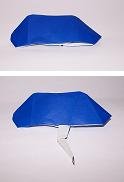 Some origami enthusiasts can target their talents into designing a specific origami models. To be able to do this, they have a solid foundation of origami know-how. They know the traditional and the new-generation origami bases. It is with this knowledge that they can purposely make the model that they want.
Some origami enthusiasts can target their talents into designing a specific origami models. To be able to do this, they have a solid foundation of origami know-how. They know the traditional and the new-generation origami bases. It is with this knowledge that they can purposely make the model that they want.
For example, on a rainy day, Peter Budai decided that he wanted to make a cloud and thunderbolt action model. With his years of experience in origami folding and a bit of experimentation, he created exactly what he wanted. [Photo: Budai’s Storm Cloud.]
Martin Wall designs origami by looking at the subject and thinking of ways to make it. He tries to break down a subject into a square – at the very least, into simpler forms. By the time he picks up a piece of paper, the method of folding is already in his mind.
- Read Peter Budai’s article on creating origami models.
- Read about Creative Method and Approach by Martin Wall
- Read about Creative Method and Approach by David Brill
Technical Design…
For those who want a high powered method of design, there’s technical designs.
When it comes to technical origami designs, the book Origami Design Secrets by Robert Lang is a must have. This 500+ page book is not like other origami books. Instead of showing you how to fold origami models, it teaches you techniques so that you can create your own models. There are a few diagrams, but these are included as an excercise to reinforce the discussed techniques.
What are some of these techniques?
Splitting Points:
 Here, Robert Lang explains how a “flap” (an origami crane has 4 “flaps: two wings, one head and one tail) can be divided into more flaps. Thus, a head can be converted into a head with a beak. A leg can be converted to a leg with toes. [Photo: Goatfish uses point splitting to create a head with a lower jaw and two barbels. Created by R Lang, folded by H Mariano.]
Here, Robert Lang explains how a “flap” (an origami crane has 4 “flaps: two wings, one head and one tail) can be divided into more flaps. Thus, a head can be converted into a head with a beak. A leg can be converted to a leg with toes. [Photo: Goatfish uses point splitting to create a head with a lower jaw and two barbels. Created by R Lang, folded by H Mariano.]
Grafting:
 The idea behind grafting is to add extra strips of paper so that you can use the extra paper to make a more detailed or better model. In reality, you don’t add strips of paper: you simply use a larger piece of paper. Some of the paper will be reserved for the original design and the extra paper will be used to for the elements you want to add. [Photo: Western Pond Turtle uses grafting
The idea behind grafting is to add extra strips of paper so that you can use the extra paper to make a more detailed or better model. In reality, you don’t add strips of paper: you simply use a larger piece of paper. Some of the paper will be reserved for the original design and the extra paper will be used to for the elements you want to add. [Photo: Western Pond Turtle uses grafting
to create the pattern on the shell. Created by R Lang, folded by H Mariano.]
Tiling:
 Origami models are often composed of repeated sections which can be called “tiles”. This is evident when you unfold the model and look at its crease pattern. Different crease patterns will provide different tiles. Robert Lang explains how you can assemble different tiles together to create new origami bases. [Photo: Centipede utilizes rectangular and triangle tiles.
Origami models are often composed of repeated sections which can be called “tiles”. This is evident when you unfold the model and look at its crease pattern. Different crease patterns will provide different tiles. Robert Lang explains how you can assemble different tiles together to create new origami bases. [Photo: Centipede utilizes rectangular and triangle tiles.
Created by R Lang, folded by H Mariano.]
Origami Design Secrets continues with a discussion of Tree Theory, Box Pleating, and other design concepts. We highly recommend the book for those who want to use a technical approach to design origami models.

- see Origami Design Secrets from Amazon.com
- go to Robert Lang’s web site
- read about and download TreeMaker, a software program developed by Robert Lang. TreeMaker helps you create crease patterns for complex origami bases.
Please Help
Please help by reporting broken links so that we can fix them. One easy message from you can save us hours and hours of clicking. Thanks!
-
More Origami Diagrams and Instructions…
-
These free origami instructions are made available to you by the paper folding community at large. If you have a diagram you would like to share, or if your diagram is listed here and you wish to have it removed, please Contact Us. Diagrams are intended for personal use. Copyright of the models lie with the origami creators and designers. Please contact the designer and/or creator directly for non-private usage of a model and/or artwork.









